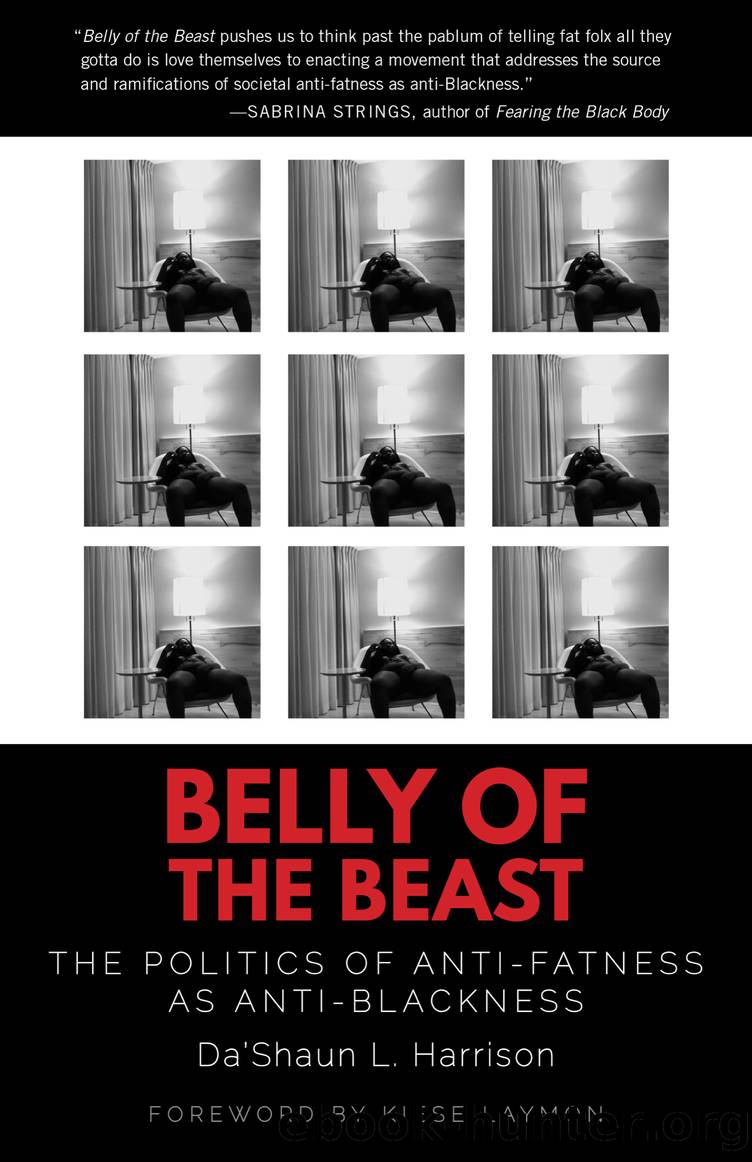Belly of the Beast by Da'Shaun L. Harrison

Author:Da'Shaun L. Harrison [,]
Language: eng
Format: epub
ISBN: 9781623175986
Publisher: North Atlantic Books
5
The War on Drugs and the War on Obesity
In March 2004, during a news conference with widespread coverage, the Centers for Disease Control and Prevention (CDC) published a report that claimed that obesity was âkilling 400,000 Americans a year,â and that it was becoming Americaâs ânumber one preventable deathââsurpassing tobacco. The CDC defines obesity as âweight that is higher than what is considered as a healthy weight for a given height.â1 Body mass index (BMI) is used as a âscreening toolâ to determine who is and is not obese. The report was published in the Journal of the American Medical Association (JAMA) which, at least at the time, was the most prestigious medical journal in the nation. Since Julie Gerberding, director of the CDC at the time, and other top CDC scientists co-authored this report, it had the credibility it needed for waves of reporters and news outlets to publish it. It would soon lead to egregious and violent headlines across the nation about fat people, fat bodies, and the alarming rate at which they were allegedly dying from obesity. It would also be cited repeatedly by officials including then-Secretary of Health and Human Services Tommy Thompson, several members of Congress, and creators of weight loss drugs seeking to draw attention and funding to anti-obesity efforts. From that moment forward, throughout the rest of that year, public officials and other media platforms used that report as evidence that obesity was the greatest threat facing the American people, and as justification for what would eventually become a forceful and strapping diet industrial complex. This was the start of the âObesity Epidemic.â
There were a few public indictments of the JAMA report, starting with Science magazine in May 2004. In a report of their own, they wrote: âSome researchers, including a few at the CDC, dismiss this prediction, saying the underlying data are weak. They argue that the paperâs compatibility with a new anti-obesity theme in government public health pronouncementsârather than sound analysisâpropelled it into print.â2 This became, at least on record, the first acknowledgment of an emerging anti-fat theme within government, health, and science institutions. Soon after Science magazineâs report, the Wall Street Journal published a story of their own that covered the errors in the study published in JAMA. On November 23, 2004, they opened their story with âAmericaâs obesity epidemic may not be as deadly as the government has claimed.â Continuing, they wrote that the study âinflated the impact of obesity on the annual death toll by tens of thousands due to statistical errors.â3 On April 30, just a month after the later-disputed report was published, Dr. Terry Pechacek, who was the associate director for science in the CDCâs Office on Smoking and Health, wrote in an email to his colleagues that he was âworried that the scientific credibility of the CDC likely could be damaged by the manner in which this paper and valid, credible, and repeated scientific questions about its methodology have been handled.â After stating that
Download
This site does not store any files on its server. We only index and link to content provided by other sites. Please contact the content providers to delete copyright contents if any and email us, we'll remove relevant links or contents immediately.
The Last Days of John Lennon by James Patterson(1005)
The Cult of We by Eliot Brown & Maureen Farrell(635)
Do Not Disturb by Michela Wrong(634)
Operation Relentless by Damien Lewis(628)
Bad Law by John Reilly(627)
The Spy Who Came in from the Cold by John le Carre(621)
Undercover War by Harry McCallion(614)
The Profession by Bill Bratton & Peter Knobler(612)
For Your Eyes Only by Ben Macintyre(609)
LOGIN TO HELL: A Hacker's Story by HILL ALBERTO DANIEL(589)
Morgue: A Life in Death by Vincent Dimaio & Ron Franscell(588)
Ruby Ridge; The Truth and Tragedy of the Randy Weaver Family by Jess Walter(581)
The Big Book of Espionage by Unknown(578)
The Ryan Green True Crime Collection by Green Ryan(578)
Uncle John's True Crime: A Classic Collection of Crooks, Cops, and Capers by Bathroom Readers' Institute(552)
The Metal Monster by A. Merritt(532)
Hollywood Heyday by David Fantle(530)
The Snow Killings by Marney Rich Keenan(529)
The Disappearance of Lydia Harvey by Julia Laite(462)
